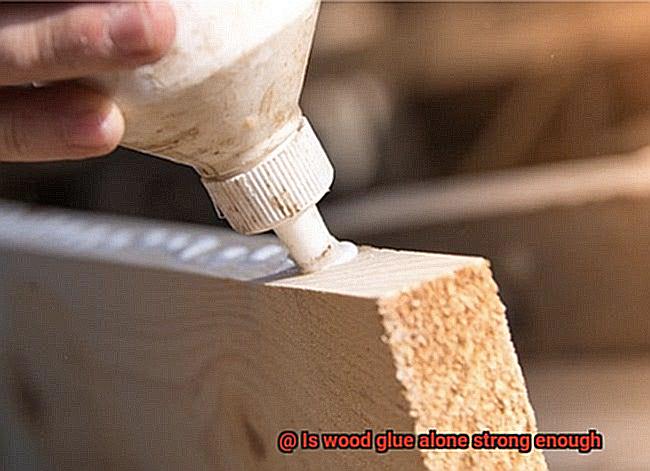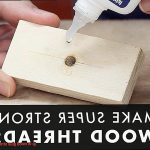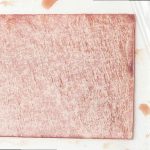Today, we’re about to embark on a mind-blowing journey that will reveal the hidden power of wood glue. If you’ve ever wondered whether this unassuming adhesive is up to snuff when it comes to durability, get ready to have your socks knocked off.
Wood glue may not always steal the spotlight from its sturdier counterparts like screws and nails, but let me tell you, it’s been a faithful sidekick in the world of woodworking for centuries. This magical substance has the ability to bring pieces of wood together, turning ordinary projects into jaw-dropping masterpieces. But here’s the burning question: can wood glue alone truly hold its ground against everyday wear and tear?
In this blog post, we’re diving deep into the nitty-gritty of using wood glue. We’ll explore its inherent qualities, potential limitations, and the techniques that make it a force to be reckoned with as a binding agent. So grab your tool belt and get ready for an eye-opening adventure as we uncover the astonishing truth about just how strong wood glue can be.
What is Wood Glue?
Contents
- 1 What is Wood Glue?
- 2 Factors That Determine the Strength of Wood Glue
- 3 Applications Where Wood Glue Alone is Sufficient
- 4 When Additional Reinforcement is Necessary
- 5 Preparing Surfaces for Glue Application
- 6 Specialized Adhesives for Greater Strength
- 7 Tips for Choosing the Right Adhesive for Your Project
- 8 Conclusion
When it comes to woodworking, finding the right adhesive is crucial for creating strong and durable bonds between wood surfaces.
Wood glue, also known as carpenter’s glue or woodworking adhesive, is a versatile and commonly used adhesive that has been a staple in woodworking projects for decades.
In this blog post, we will delve into what wood glue is, its different types, and its applications in woodworking projects.
What is Wood Glue?
Wood glue is a specialized adhesive formulated specifically for bonding wood surfaces together. It is made up of a water-based polymer resin that forms a strong and durable bond when it dries.
Wood glue typically comes in two main types: polyvinyl acetate (PVA) and aliphatic resin. PVA wood glue is the most common type and is suitable for general woodworking applications, while aliphatic resin glue is known for its superior strength and resistance to heat and moisture.
Penetration and Gap-Filling Properties:
One of the key characteristics of wood glue is its ability to penetrate the porous surface of wood, ensuring a strong bond that often surpasses the strength of the wood itself.
This penetration helps distribute the adhesive evenly throughout the wood fibers, resulting in a solid bond. Additionally, wood glues have excellent gap-filling properties, allowing them to fill small gaps or imperfections in the wood surface.
Versatility:
Wood glue goes beyond just bonding wood surfaces together. Certain types of wood glue can also be used to bond other materials such as paper, cardboard, fabric, and some plastics.
However, it is important to choose the appropriate adhesive for each specific application, as different glues are formulated for different materials.
Application Techniques:
To achieve optimal bonding strength with wood glue, proper surface preparation is essential. The wood should be clean and free from dirt, oils, and other contaminants that can hinder adhesion. Additionally, proper clamping during the curing process ensures maximum contact between the glued surfaces. Following manufacturer instructions and consulting woodworking experts or professionals will help ensure the best adhesive solution for your specific project.
Strength and Considerations:
Wood glue alone can provide a strong bond that can withstand typical stress and strain experienced by wood. However, for applications that require exceptional strength or durability, additional reinforcement methods like screws, dowels, or other mechanical fasteners are often recommended. Specialized adhesives like epoxy or polyurethane can offer even greater strength when maximum bonding capabilities are needed.
Factors That Determine the Strength of Wood Glue
Whether you’re a seasoned woodworker or just getting started, understanding the factors that determine the strength of wood glue is essential for successful woodworking projects.
In this article, we’ll dive deep into the world of wood glue and explore the various factors that influence its bonding strength. So, grab your favorite woodworking beverage and let’s embark on this journey.
Type of Wood Glue:
Different types of wood glue have varying bonding properties. PVA glue, known as “yellow glue,” is perfect for general woodworking projects. Polyurethane glue offers exceptional water resistance and can bond different materials effectively.
Epoxy glue is ideal for high-stress applications, while hide glue is favored by traditional woodworkers for its reversible properties.
Surface Preparation:
The secret to a strong bond lies in proper surface preparation. Ensure that the surfaces to be glued are clean, dry, and free from any dust or debris. A light sanding will create a rough texture, promoting better adhesion between the wood and the glue.
Clamping Pressure:
Applying adequate clamping pressure during the drying process is crucial for achieving a strong bond. This pressure helps squeeze out excess glue and ensures that the surfaces are in close contact with each other. Insufficient clamping pressure can result in weak joints and reduced bonding strength.
Drying Time:
Each type of wood glue has specific drying times stated by the manufacturer. Rushing the drying process can compromise the bond’s strength, as the glue may not have had enough time to fully cure and create a robust hold. Patience is key here.
Temperature and Humidity:
Environmental conditions play a significant role in the strength of wood glue bonds. High temperatures can accelerate drying but may also cause premature curing, resulting in weaker bonds. Similarly, high humidity levels can slow down drying and affect the overall bond strength. Finding the sweet spot for temperature and humidity ensures optimal results.
Wood Species:
The type of wood being glued together can impact bond strength. Some wood species, like teak or cedar, are naturally oily or resinous, making it challenging for glue to adhere effectively. In these cases, specialized adhesives or surface treatments may be necessary.
Joint Design:
The design and construction of the joint play a vital role in bond strength. Well-fitted joints with a large surface area for glue application generally result in stronger bonds. Consider using techniques such as mortise and tenon joints or dovetail joints for added strength.
Glue Age and Condition:
Wood glue has a limited shelf life, so always check the expiration date and ensure proper storage. Using expired or deteriorated glue can lead to weaker bonds and compromise your project’s integrity.
Applications Where Wood Glue Alone is Sufficient
Wood glue, also known as carpenter’s glue or PVA glue, is a versatile adhesive that finds its place in various woodworking projects. While it may not be the strongest adhesive available, there are several applications where wood glue alone is sufficient. In this blog post, we will explore these applications and discover the many uses of wood glue in woodworking projects.
Joining Two Pieces of Wood:
Wood glue shines when it comes to joining two pieces of wood together. Whether you’re constructing furniture, cabinetry, or any other woodworking project, wood glue provides a bond that can withstand the weight and stress placed on the joint. With clean surfaces free from dust and debris, apply a generous amount of wood glue and watch it create a strong connection that will last for years.
Edge Gluing Boards:
When it comes to creating wider panels by edge gluing boards, wood glue is the go-to adhesive. This technique is commonly used in tabletops, countertops, and other large surface areas. Wood glue creates a sturdy bond along the edges of the boards, resulting in a seamless and robust surface. Secure the pieces tightly with clamps while the glue sets to ensure a tight fit.
Wood Veneer Application:
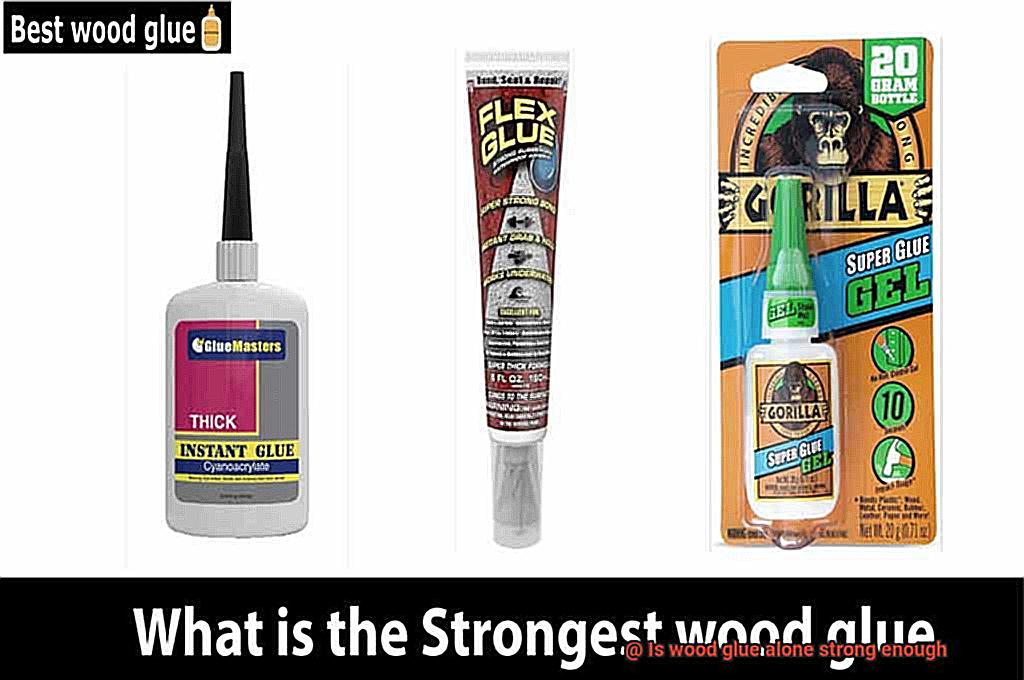
Wood veneer application is another area where wood glue alone can work wonders. Veneer, the thin layer of wood glued onto a substrate for an attractive finish, requires a strong bond to stay securely in place. Wood glue provides exactly that, ensuring the veneer remains firmly attached over time. Clamp the veneer with even pressure to prevent unsightly bubbles or wrinkles.

Repairing Wooden Furniture and Items:
When it comes to repairing wooden furniture or other items, wood glue alone can often do the trick. Whether it’s fixing a loose chair leg or reattaching a broken piece of trim, wood glue provides a durable and long-lasting bond. Ensure the surfaces are clean and properly aligned before applying the glue, and consider clamping the pieces together to aid in a strong bond.
Non-Structural Woodworking Projects:
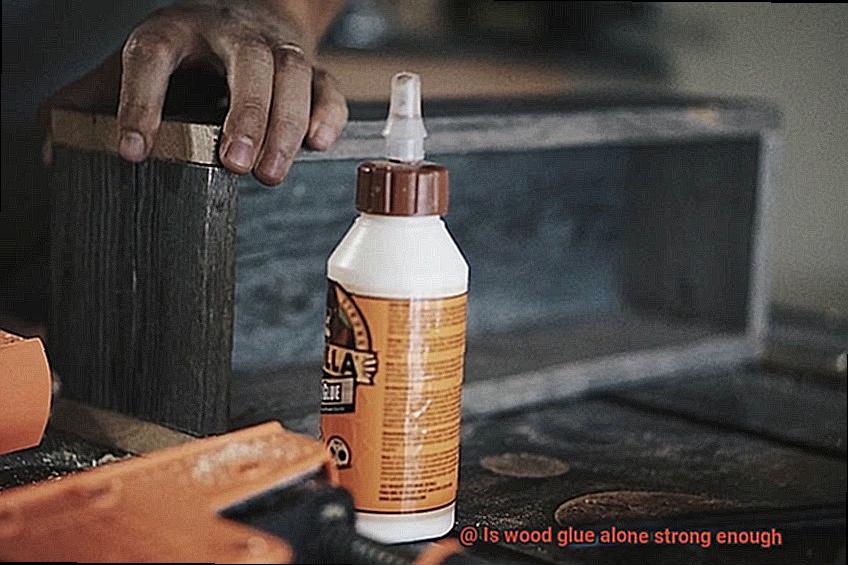
For woodworking projects that involve non-structural components like decorative trim, moldings, or small wooden crafts, wood glue alone is often sufficient. These applications don’t require the same level of strength as structural joints, making wood glue an ideal adhesive choice. Follow the manufacturer’s instructions for proper application and drying time, and enjoy the ease of using wood glue for your creative projects.
When Additional Reinforcement is Necessary
In this article, we will explore when additional reinforcement becomes necessary in woodworking projects and discuss various factors that influence the need for extra support.
Large or Heavy Objects:
When working on substantial pieces like furniture or structural components, relying solely on wood glue may not be sufficient. The weight and stress placed on these objects can weaken the glue joints over time. To ensure stability and longevity, additional reinforcement in the form of mechanical fasteners, such as screws or nails, can be used to provide extra strength.
High Stress Areas:
Certain areas of a woodworking project experience higher levels of stress or strain than others. Joints that bear weight or endure frequent movement require added reinforcement for long-lasting stability.
Wood glue alone may not withstand continuous pressure or repeated use in these high-stress areas. Enhance strength and durability by using techniques like doweling, biscuit joinery, or mortise and tenon joints in combination with wood glue.
Moisture and Temperature Variations:
Wood is a natural material that expands and contracts with changes in moisture and temperature. While wood glue is generally water-resistant, excessive exposure to moisture or extreme temperature variations can weaken its bond.
In environments with high humidity or outdoor applications exposed to rain and sunlight, additional reinforcement is often required. Incorporating waterproof adhesives or mechanical fasteners can help ensure the project’s longevity under challenging environmental conditions.
Longevity and Structural Integrity:
If you want your woodworking project to last for generations, consider additional reinforcement methods beyond wood glue alone. Even the strongest wood glue bonds can deteriorate over time due to aging, environmental factors, or constant use. Enhance structural integrity and longevity by incorporating reinforcement techniques like dovetail joints, splines, or corner blocks.
Cosmetic Considerations:
While wood glue is an excellent adhesive for joining pieces of wood together, it may not always provide a seamless or aesthetically pleasing finish. In situations where a flawless appearance is desired, additional reinforcement methods can ensure both visual appeal and structural integrity. Hidden fasteners, decorative dowels, or wooden plugs can be utilized to achieve a clean and polished look.
Preparing Surfaces for Glue Application
To achieve an unbreakable connection, proper surface preparation is paramount. In this article, we will delve into the importance of surface preparation, necessary materials, step-by-step instructions, and tips for ensuring a secure bond that will withstand the test of time.
Importance of Surface Preparation:
Surface preparation serves as the bedrock for successful glue application. It allows the adhesive to penetrate and bond effectively, maximizing its adhesive properties. Without proper preparation, even the strongest glue will struggle to forge a lasting bond. By devoting time to this critical step, you can bolster the strength and durability of your woodworking projects.
Materials Needed:
To prepare surfaces for glue application, gather the following materials:
- Clean cloth or brush: These tools will help eliminate any dust, dirt, or debris from the surfaces. A pristine surface ensures superior adhesion.
- Sandpaper: Opt for sandpaper with varying grits depending on surface condition. Coarse grits (80 or 120) are ideal for rough or uneven surfaces, while finer grits (180 or 220) create a velvety smooth canvas.
- Sanding block: A sanding block provides stability and control during sanding, ensuring an even surface that is ready for bonding.
- Chemical strippers (if needed): If the surfaces bear existing finishes such as paint or varnish, chemical strippers can effectively remove them.
Steps to Prepare Surfaces:
Follow these steps to prepare surfaces for optimal glue application:
- Clean the surfaces: Employ a clean cloth or brush to thoroughly wipe down the surfaces, eliminating any loose particles.
- Sand the surfaces: Utilize sandpaper and a sanding block to achieve a smooth and even surface. Sand in the direction of the wood grain for optimal results.
- Remove existing finishes: If the surfaces sport paint, varnish, or other finishes, employ appropriate methods like sanding or chemical strippers to remove them.
- Check moisture content: Before applying glue, ensure that the wood possesses an appropriate moisture content. Excessive moisture can impede proper bonding.
Ensuring a Secure Bond:
To guarantee a secure bond, consider the following tips:
- Apply even pressure: Utilize clamps or weights to firmly hold the surfaces together while the glue cures. This ensures optimal adhesion and minimizes the risk of joint failure.
- Allow sufficient drying and curing time: Adhere to the manufacturer’s instructions regarding drying and curing time. Rushing this process can compromise bond strength.
Specialized Adhesives for Greater Strength
Are you ready to take your bonding game to the next level, glue enthusiasts? Traditional wood glue just isn’t cutting it anymore. It’s time to discover the wonders of specialized adhesives that can give your projects that extra oomph of strength they need. Let’s dive in and explore the advantages of using specialized adhesives over your run-of-the-mill wood glue.
Epoxy Resin – The Bonding Legend:
When it comes to exceptional strength, epoxy resin takes the crown. This adhesive is like Hulk-level strength for your projects. It consists of two components, a resin and a hardener, that when mixed together create a bond that can withstand heavy loads and extreme conditions.
Polyurethane Glue – Filling the Gaps:
Say goodbye to weak joints and hello to polyurethane glue. This adhesive expands as it cures, filling any gaps or voids in your joint. Not only does it create a stronger bond, but it also provides additional reinforcement. No room for weakness here.
Super Glue – The Speedster:
Need a quick fix? Look no further than cyanoacrylate glue, a.k.a super glue. This lightning-fast adhesive forms an instant bond when in contact with moisture, making it perfect for small repairs or time-sensitive projects. Fast and strong – a dynamic duo.
Structural Adhesives – Building Blocks of Strength:
For load-bearing applications, structural adhesives are your go-to choice. They are formulated to bond various materials, including wood, metal, and plastic. These heavy-duty adhesives provide exceptional strength, ensuring your project can handle anything life throws at it.
But wait, there’s more.
Remember, specialized adhesives work best when combined with reinforcing techniques. Using dowels or screws in conjunction with these adhesives can enhance the overall strength of your joint. It’s like adding a secret ingredient to an already delicious recipe.
By now, you should be ready to step up your glue game with specialized adhesives. Whether it’s the Hulk-like strength of epoxy resin, the gap-filling abilities of polyurethane glue, or the lightning-fast bonding of super glue, there’s a specialized adhesive for every situation. Choose the right adhesive and reinforce it like a pro. Your projects will thank you for the extra strength and durability.
Tips for Choosing the Right Adhesive for Your Project
When it comes to completing a project, choosing the right adhesive can make all the difference. Whether you’re working with wood, metal, or paper, finding an adhesive that meets your needs is crucial. Here are some tips to help you select the perfect adhesive for your project.
Consider the materials:
The first step in choosing the right adhesive is considering the materials you’ll be working with. Different adhesives work better on specific materials, so make sure to choose one that matches what you’re using. For example, if you’re working with wood, a wood glue or carpenter’s glue would be a good choice. For metals, look for an adhesive designed for metal bonding.
Evaluate the strength requirements:
Think about how strong your bond needs to be. If you’re joining heavy or load-bearing materials, like metal or glass, you’ll need a strong adhesive that can handle the weight. On the other hand, for lighter projects like crafting or paper arts, a less strong adhesive may be enough. Consider the weight and stress your project will endure to determine the required strength.
Consider the application method:
Adhesives come in different forms like liquid, gel, tape, or spray. The application method can impact how easy and effective the adhesive is to use. Liquid adhesives are versatile and can be applied with a brush or nozzle. Gel adhesives give you more control and prevent dripping. Tape adhesives are quick and convenient for temporary bonds, while spray adhesives cover large surfaces evenly.
Assess drying time:
Think about how quickly you need your adhesive to dry. Some adhesives dry within minutes, while others take hours or even days to fully cure. Consider whether you need an adhesive that allows for repositioning before it sets or if you need an instant bond. Remember, temperature and humidity can also affect drying time, so keep that in mind.
Take into account flexibility and expansion:
If your project involves materials that expand or contract with temperature or humidity changes, you’ll need a flexible adhesive. For example, wood naturally expands and contracts, so a flexible adhesive is ideal to prevent cracks or separation. Make sure to choose an adhesive that can withstand any movement or expansion your project may face.
Conclusion
Wood glue alone is not strong enough to provide a reliable and durable bond.
While it may be sufficient for certain lightweight applications, such as crafts or small repairs, it lacks the strength and durability required for more demanding projects. In these cases, additional reinforcement or alternative adhesives are necessary to ensure a secure and long-lasting bond.
Instead, consider using stronger adhesives like epoxy or polyurethane glue, which offer superior bonding capabilities and can withstand greater forces.

